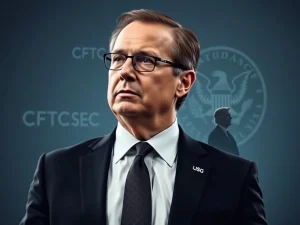Urgent Push: US Lawmakers Advance Critical Crypto Market Structure Bill Amid Shutdown

The cryptocurrency world often experiences rapid shifts. However, even seasoned observers are surprised by the current legislative efforts. Amidst a significant US government shutdown, lawmakers are making an urgent push to finalize a critical US crypto bill. This unexpected development signals a determined effort to bring clarity to the digital asset space, even as other governmental functions face disruption. The commitment shown by key senators highlights the growing importance of establishing a clear crypto market structure for the future of finance.
The Unwavering Push for Crypto Market Structure
Despite the broader federal paralysis, reports indicate a steadfast determination within the Senate. Notably, a Bloomberg report confirmed that several influential Republicans, including those holding leadership roles on critical committees, aim to pass legislation on crypto market structure by year-end. This timeline aligns with their initial commitments, underscoring a consistent legislative agenda for digital assets. Furthermore, this resolve persists even as thousands of government employees remain furloughed across various agencies. Congress members, however, continue to receive their salaries, enabling them to conduct business in both the House and Senate. This distinction allows the legislative process to continue moving forward.
The urgency surrounding this legislative push is palpable. Many in the industry believe a defined framework is long overdue. A robust crypto market structure would provide much-needed stability. It would also foster innovation within the rapidly evolving digital asset ecosystem. Lawmakers recognize the economic potential of cryptocurrencies. Consequently, they prioritize creating a regulatory environment that supports growth while protecting investors.
Navigating Digital Asset Regulation Amidst Political Turmoil
The ongoing negotiations for comprehensive digital asset regulation are intricate. John Boozman, who chairs the Senate Agriculture Committee, recently stated his active engagement with Democrats. He reportedly seeks to release a bipartisan bill on market structure “very, very soon.” His ambitious plan aims to pass this crucial legislation before 2026. Moreover, this bipartisan cooperation extends beyond his committee. Members of the Senate Banking Committee, another essential body for bill approval, have also resumed their discussions. A possible deal could emerge in a matter of weeks, according to sources. This collaboration is vital for navigating the complex political landscape.
Establishing clear digital asset regulation is paramount for the industry’s maturation. Currently, the lack of a unified framework creates uncertainty. This uncertainty can deter institutional investment and hinder broader adoption. Therefore, lawmakers are diligently working to define roles and responsibilities. They aim to clarify which agencies oversee various aspects of the crypto market. This effort will ultimately foster a more predictable and secure environment for all participants.
The Journey of the US Crypto Bill: From House to Senate
The legislative battle for a comprehensive US crypto bill gained momentum earlier this year. It commenced with the passage of the CLARITY Act in the House of Representatives. This occurred in July, as part of Republicans’ designated “crypto week” initiatives. Following this, party leaders in the Senate expressed their intention to “build on” the House bill. Their goal was to create their own version of crypto market structure legislation. This new proposed framework operates under the title of the Responsible Financial Innovation Act. This demonstrates a coordinated, albeit multi-chamber, approach to regulation.
The development of a robust US crypto bill is a multi-stage process. The House’s initial efforts laid foundational groundwork. Now, the Senate is meticulously refining these concepts. They are addressing specific concerns and incorporating broader industry feedback. This ensures the final legislation is comprehensive and effective. Ultimately, the aim is to provide a clear path forward for digital assets within the existing financial system.
Senate Crypto Legislation Faces Deadlines and Obstacles
Wyoming Senator Cynthia Lummis, a vocal proponent of the legislation, previously set ambitious targets. In August, she expressed hopes for the Senate crypto legislation to reach the Agriculture Committee by the end of September. She further anticipated consideration by the Banking Committee by the close of October. Her vision included US President Donald Trump signing it into law by 2026. However, one committee deadline has already passed. The other benchmark now appears unlikely to occur amidst the ongoing government shutdown. These delays highlight the unpredictable nature of the legislative calendar. Despite these setbacks, the commitment to pass the bill remains firm among key senators.
The intricacies of passing significant Senate crypto legislation are numerous. Committee hearings, markups, and floor votes all require careful scheduling. A government shutdown complicates these processes significantly. Resources are limited, and legislative priorities can shift. Nevertheless, the continued efforts underscore the perceived importance of this bill. Lawmakers understand that providing regulatory certainty is crucial for the nation’s economic competitiveness in the digital age.
Coinbase’s Advocacy Reinforces Drive for Government Shutdown Crypto Progress
The push from Congress gained additional impetus following Coinbase CEO Brian Armstrong’s recent visit to Washington, D.C. Armstrong met with lawmakers, advocating for clearer regulations. He reported that the Senate was “working hard” on the bill. Furthermore, he noted a significant level of agreement, with senators reportedly aligning on about 90% of the issues surrounding crypto in the legislation. This positive feedback from a major industry player undoubtedly fuels the ongoing efforts. It validates the legislative direction even during the current government shutdown crypto discussions.
The industry’s voice plays a critical role in shaping effective regulation. Armstrong’s engagement demonstrates the desire for collaboration between policymakers and innovators. His insights help bridge the gap between technical realities and legislative requirements. This dialogue is essential for creating a practical and forward-thinking framework. Ultimately, the goal is to achieve meaningful progress on government shutdown crypto legislation. This will ensure the US remains a leader in digital finance.
Why Regulatory Clarity Matters for Digital Assets
Regulatory clarity is not merely a preference; it is a fundamental necessity for the digital asset space. A clear framework provides a stable environment for innovation. Developers and entrepreneurs can build new products and services with confidence. They understand the rules of engagement. Moreover, it significantly enhances consumer protection. Defined regulations ensure that investors are safeguarded against fraud and manipulation. This fosters trust in the market. Furthermore, institutional adoption hinges on regulatory certainty. Large financial institutions require clear guidelines before committing significant capital to digital assets. They need to understand their legal obligations and risks. Without this, widespread institutional participation remains limited. Consequently, a comprehensive digital asset regulation framework would unlock immense potential for growth and stability in the crypto economy.
Potential Impact on the Broader Financial Landscape
The passage of a comprehensive US crypto bill holds profound implications for the broader financial landscape. Such legislation could facilitate the seamless integration of digital assets into traditional finance. It would establish common standards and practices. This integration could lead to new financial products and services. These offerings would blend the best of both worlds. Additionally, clear regulations can bolster the United States’ position in global financial innovation. Other nations are actively developing their own crypto frameworks. Therefore, a proactive approach ensures the US remains competitive. It also attracts talent and investment. Ultimately, a well-defined crypto market structure could redefine how value is transferred, stored, and managed worldwide, ushering in a new era of financial possibility.
The ongoing legislative efforts in the US Senate represent a critical juncture for the cryptocurrency industry. Despite the backdrop of a government shutdown, lawmakers continue their determined push to establish a clear crypto market structure. This bipartisan commitment to pass a comprehensive US crypto bill underscores the growing recognition of digital assets’ importance. As negotiations progress, the industry watches closely, anticipating the clarity that a robust digital asset regulation framework promises. The outcome of this Senate crypto legislation will undoubtedly shape the future trajectory of cryptocurrencies, regardless of the challenges posed by the current government shutdown crypto environment.









